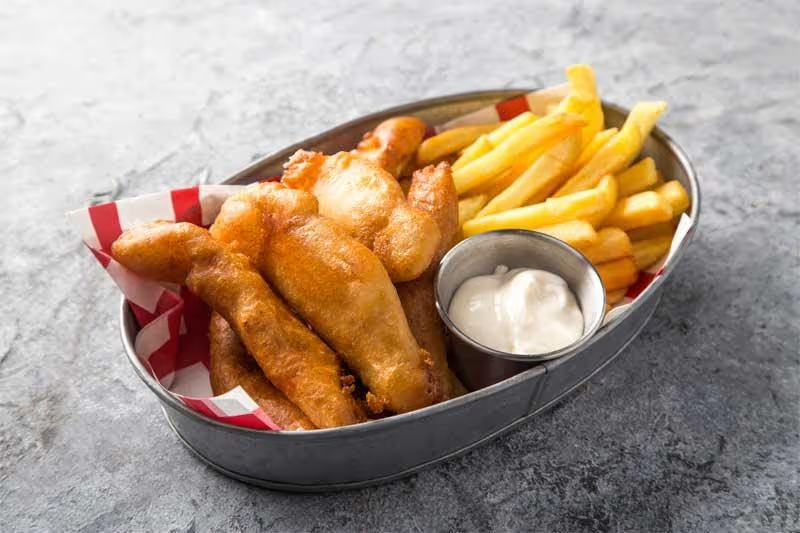A beer-battered fish that is deep-fried, served with potato chips and tangy lemon mayonnaise on the side.
Any kind of aquatic life that is regarded as food fit for consumption by humans is called seafood and includes fish and shellfish.
Fish are of two kinds, either 'Round fish or Flat fish' and come from Salt water (Ocean) or Fresh water (Dams, Rivers and Lakes). On the other hand, shellfish include various species of Molluscs (Squids, Mussels, Oysters, Octopus) and Crustaceans (Lobsters, Crabs, Shrimp).
The most important factor to look into when choosing fish for a dish is the color of the flesh. The flesh is described as either 'white or dark' and the dark colored fish can range from a pinky-red to orange or even brown in color. The oil content within the flesh determines the color; the higher the oil content the darker the color.
Classification and category of fish and shellfish helps determine the method of cooking that could be suitable for each kind.
Points to keep in mind when choosing fresh fish!
- The eyes must be bulging, bright and shiny with jet-black pupils (not sunken and never bloody).
- Gills must be bright red in colour and moist with mucus (when not fresh, the gills will be brown and dry).
- Flesh should be firm, elastic and translucent, without blood clots or areas of discoloration.
- Scales should be shiny, plentiful, moist, firmly attached and lie flat against the body.
- Odour – Fresh fish have a clean sea smell, the smell intensifies and becomes unpleasant the longer the fish is out of the water.
When choosing fresh molluscs, it is important to check:
- Shells – The shell of un-shucked live molluscs like mussels & oysters should be tightly closed. If the shells are open and do not close when tapped, then they are dead. Likewise, discard molluscs if shells do not open when cooked.
- Flesh – Shucked molluscs like oysters & scallops should have juicy plump flesh that is free from grit and have a sparkling appearance. Note: if water oozes from fresh scallops when you press on the flesh, it means they have been soaked in warm salty water to swell them. Suppliers do this to increase their weight for selling.
- Odour – All molluscs should have a fresh, clean 'sea' smell.
- Skin – Molluscs like octopus & squid should have moist skin with a slimy feel. All tentacles should be intact, not broken.
When choosing fresh crustaceans, it is important to check:
- All legs and claws should be intact, which is a sign of careful handling.
- There should be no damage to the body armour and no discolouration.
- Hard-shelled crustaceans like lobsters & crabs should be lifted to make sure that they are heavy in proportion to their size without having water sloshing around inside their shell.
- The eyes should be plump, glossy black rather than dull, discoloured and pale.
- Prawns and shrimps should have a tight shell that is undamaged with no black discolouration or stickiness on the shell.
Fresh or frozen fish should be purchased just before leaving the market so it is exposed to unsafe temperatures for as short a time as possible. It should be placed in a plastic bag to prevent any leakage from contaminating any other foods.
Edible sea plants, such as seaweed and microalgae, are also widely eaten around the world, especially in Asia and they are also classified under seafood.
Whether it's a delicious plate of pasta with shrimp, a steaming lobster or a salmon fillet cooked to flaky perfection, seafood is incredibly popular around the world. In some countries, seafood isn't just the main meat that most people get to eat but one of the main food staples.
Some popular Seafood include...
1. Salmon
Salmon flesh is pink and firm, with a unique taste that’s rich and mild at the same time. As an added bonus, salmon is a great source of Omega-3 fatty acids and vitamin D. Salmon can be prepared in a variety of ways, including grilled, smoked, poached, or served raw in sushi or sashimi.
2. Tuna
Tuna flesh is dense and flavourful, full of protein, and low in saturated fat. Tuna can be served just about any way imaginable but grilled tuna steak is tasty enough to tempt even the most hardened meat lover.
3. Cod
Cod flesh is dense, flaky, and white, with a low fat content and a mild flavour that makes it popular in North America, the United Kingdom, Portugal, and Spain. Cod (along with haddock and plaice) is commonly battered and deep fried to be served as fish and chips.
4. Lobster
Found on the rocky, sandy, or muddy bottoms of the entire world’s ocean, lobsters are the largest (and most sought-after) shellfish. Lobster flesh is tender and succulent, with a sweet taste. Most people prefer it steamed, baked, grilled, or simply boiled and served with butter sauce.
5. Oysters
Oysters can be poached, marinated, fried, grilled, baked, or could even be served raw with lemon juice, horseradish, and a variety of sauces.
6. Caviar
Considered a premium delicacy around the world and nothing but processed, salted sturgeon roe. The most popular (and most expensive) caviar comes from the sturgeons of the Caspian Sea.
7. Shrimp
Found near the bottom of fresh and salt water bodies, shrimp live in schools and have the unique ability to swim backwards. No matter what the variety of shrimp, they are prepared by removing the shell, the tail, the head, and the “sand vein”. Shrimps are rich in calcium & protein, and could be baked, boiled, fried, or grilled.
8. Crab
This cousin to the shrimp and lobster has meat that is tender and delicious. Smaller species, such as the soft-shell crab are even eaten whole. For the larger specimens, such as the snow crab, only the meat from the legs and claws are eaten. The meat can be mixed with flour to make crab cakes or even strained into broth to make bisque.
9. Scallops
The delicate, white meat of this mollusc is protected by a brightly colored, fan-shaped shell. Found in all the world’s oceans, the scallop is popular in both in Eastern and Western cooking. They can be sautéed, fried, steamed, grilled or even served raw as sushi or sashimi.
10. Squid
This versatile meat can be fried, grilled or stewed and stuffed with rice, cheese, vegetables, or other types of seafood. When used for food, squid is often referred to by its Italian name, “calamari”.
Seafood Recipe of the Day - Fish & Chips

About Fish & Chips
Fish & Chips is the undisputed National dish of Great Britain; it has become the cultural & culinary symbol of the country and instantly recognized as British the world over.
From the 1870’s the fish and chip trade spread rapidly, especially in London and in the cotton & wool manufacturing towns of the Pennines and soon becoming a readily accessible hot, nutritious meal for many factory and mill workers then.
This Dish
A beer battered fish that is deep fried, served with potato chips and tangy lemon mayonnaise on the side.
Recipe Card (to serve 4 pax)
Method of Cooking
- Slice potatoes with skin into chips. Parboil the potatoes for 5 minutes, drain and place in the freezer for 20 minutes.
- Combine all ingredients for the lemon mayonnaise and put it a ramekin and place in the fridge to chill.
- Pour the sunflower oil into the deep fat fryer or a large frying pan and heat it to 180˚C (just below smoking point).
- Mix the salt and black pepper together and season the fish fillets on both sides.
- Deep fry the potato in the oil until they are golden and crisp. Place on a paper towel to soak excess oil and set aside.
- Whisk the flour & corn starch together with beer, vinegar and baking powder until it has no lumps(add the beer little at a time). Coat each side of the fish fillet in a little of the extra flour, then dip into the batter and allow any excess better to drop off.
- Holding one end, lower the fish into the oil one by one, carefully. The size of your fryer will determine the number of fish you can fry at a time. Make sure not to overcrowd the fryer.
- Cook for around 4 minutes or so, until the batter is golden and crisp.
- Serve on a plate or in paper cone with the lemon mayonnaise.







.avif)


.avif)
.avif)